StinkBug
Cleared for Takeoff
My club keys all the planes alike and all members have a key. It's on the member to obey the rules. We're all supposed to be adults, and shouldn't need babysitters. Sometimes people have to act like children though.
It is amazing the abuse some planes take by student pilots. We all were there at one point so I'm not looking to throw stones here but I'm just in awe of how sturdy Cessna and Piper make airplanes.
Ah, yes-the seldom-seen 152RG with the adjustable thrust line option...Pics: (I know they're tiny)
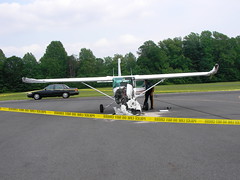
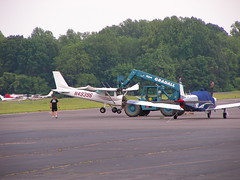
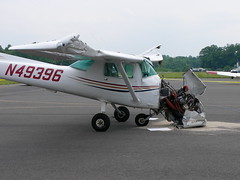
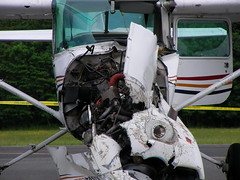
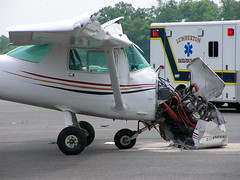
Land too flat and it will porpoise. There's a video on Youtube of a low-wing piper doing exactly that. The nosewheel hits and forces the nose up, and the wing flies away. The pilot pushes the nose down...
This is so true. I once had to tell an instrument rated pilot to go around because she seemed determined to prang her nose gear. Classic PIO/porpoise trying to plant the plane on the runway. I let it go for two bounces then had to say something - wasn't going to let someone injure a beautiful Cardinal for no reason.I don't think it matters much that it was a student. You have no idea how many "seasoned" pilots I see do PIO. First nose bounce, I remain quiet, second nose bounce, I say "add power, power", third bounce, I am bracing for impact. So far, I am still here to tell the story.
I'd be surprised if an instructor put a limitation on a student pilot higher than the demonstrated crosswind. Most planes can handle more but a student pilot? Why hang your neck out?I have to look at my log book but I do not believe I was limited to Winds at 20 knots. I believe I was limited to Cross Winds at 20 knots. Big difference as if the winds were down the pipe, I was good to go. Now my personal minimums would not have allowed it but I was signed off to fly in much more then I would have wanted to.
HOW?!
You don't understand PIO?
You don't understand PIO?
They called it porpoising in the faa Airplane Flying Handbook, page 8-31, figure 8-37. Sounds like you were just taught how to avoid it without covering the term PIO. PIO is more general than that though and applies to any oscillation where the pilot and plane are out of sync, as in trying to hit a speed, overshooting, over-correcting, undershooting, repeat, etc.Hell no I don't understand PIO. I didn't even know it was a thing until this conversation. And that video boggles my freakin' mind...
I was taught from DAY ONE that if you bounce the first time (Cessna 172 springy legs) then you carried too much speed into it or didn't flare properly... and that after the first bounce, do NOT lower the nose. Your two options are add a touch of power to cushion the next contact, or go around. It was drilled home from my first landing that you do NOT lower the nose to correct for bad landing technique.
It's discussions like this that make me glad I had PIO trained out of me on day one. To get some cross-wind practice in I took the 172 out in 15 knots gusting 30 the other day. Other than a disconcerting wing drop I didn't have too much trouble. Had to abort during one approach but the others were quite smooth and down the centerline. More people should go up (either with or without an instructor) on a gusty day to get used to landing with strong winds if they're out of practice. 90% of the time it's a non-event but reinforces good habits and highlights bad ones.
30 knots is no joke in a 172 - was it direct across? IME That strong of a crosswind in the 172 will result in running out of rudder authority and side loading the gear.
That's how I was taught as well. In my Cardinal, I will sometimes just hold back pressure after the first bounce; but a second bounce always prompts a touch of power on a long runway, or a go-around otherwise.Hell no I don't understand PIO. I didn't even know it was a thing until this conversation. And that video boggles my freakin' mind...
I was taught from DAY ONE that if you bounce the first time (Cessna 172 springy legs) then you carried too much speed into it or didn't flare properly... and that after the first bounce, do NOT lower the nose. Your two options are add a touch of power to cushion the next contact, or go around. It was drilled home from my first landing that you do NOT lower the nose to correct for bad landing technique.
Granted I have flown most of my time in a pretty docile Warrior, but I have never bounced, I hope I am not jinxing myself. I have always thought that I would put in the power on the first bounce.
That's one famous video, although it's a little sad that the stolen instance has more views than the original. However, here's one that's even funnier. Count the ways: it's a twin, it's a turboprop, the solo student receives radio instructions from the Flight Manager (make sure to reduce the sound volume, it's very loud). You would not think we would let anyone who can't deal with porpoising to fly an airliner? Welcome to the new world of ab-initio airline training, soon coming to these united states too.There's a video on Youtube of a low-wing piper doing exactly that.
That's one famous video, although it's a little sad that the stolen instance has more views than the original. However, here's one that's even funnier. Count the ways: it's a twin, it's a turboprop, the solo student receives radio instructions from the Flight Manager (make sure to reduce the sound volume, it's very loud). You would not think we would let anyone who can't deal with porpoising to fly an airliner? Welcome to the new world of ab-initio airline training, soon coming to these united states too.
30 knots is no joke in a 172 - was it direct across? IME That strong of a crosswind in the 172 will result in running out of rudder authority and side loading the gear.
I simply don't understand why a pilot would deliberately hold a flat attitude while landing a tricycle gear airplane. FLARE, fercrissake.
I simply don't understand why a pilot would deliberately hold a flat attitude while landing a tricycle gear airplane. FLARE, fercrissake.
A fast approach means that the airplane is less nose-up, and if the pilot tries to flare at that speed the airplane will climb. We call that ballooning.
I have no doubt excessive speed accounts for some cases of flat landings/porpoise incidents. However some pilots deliberately try to plant the airplane on the runway even when approaching at an acceptable speed. IOW they just don't flare. The pilot I was referring to wasn't coming in at all hot. It simply seemed that she had been taught to land that way. The next time around she did the same thing, but somehow managed to get the plane down and stopped. I asked her if she wanted to inspect the nosegear but she declined, saying it was okay.Go back to basic aerodynamics. Chapter one. Angle of attack is directly related to airspeed. Less airspeed means a high AoA to maintain flight. More speed means less AoA. A fast approach means that the airplane is less nose-up, and if the pilot tries to flare at that speed the airplane will climb. We call that ballooning. The ONLY fix is to approach at a proper speed, get the power back and the nose coming up somewhat before you get into ground effect, and continue raising the nose as the speed falls until the mains touch. If you land at a high airspeed, the attitude is flat and the nosewheel hits first and we get started on a porpoise.
30kts shouldn't be that big of a issue, 0 flap shouldn't be too much of a pucker factor.
Album with larger ones... https://www.flickr.com/photos/f2f4/albums/72157618796120892Pics: (I know they're tiny)





The problem for this student pilot is that he ignored or was unaware of his wind limitation.
Man, Threads like this make a guy starting his training at the end of next month scared
This incident highlights the reason many flight schools do not permit releasing aircraft to student pilots without a staff member giving the okay. QUOTE]
Air Force aero clubs have what is called the SOF (supervisor of flying) and I'm sure the Army n Navy aero clubs have something similar. All flights had to go thru that individual before one could take an airplane. Works pretty well in my opinion.
Looks like the plane I did my discovery flight in is no more.
